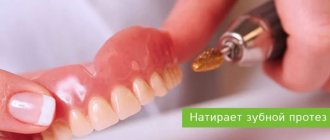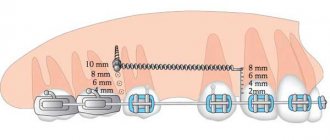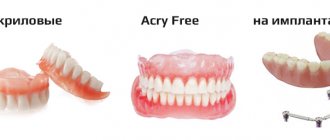Prosthetic technologies are improving, modern orthodontic implants are natural and comfortable to use. High aesthetic results of bridges and implants are achieved through the use of the latest technologies for the production of orthopedic material. Telescopic crowns are used to preserve intact teeth and to restore lost ones. Let's consider their types, the material used and the design of prostheses on telescopic crowns.
When are telescopic crowns used?
The main reason for prescribing telescopic (combined) crowns is the absence of a large number of natural molars in the jaw. Due to edentia, it is impossible to install a clasp prosthesis, so an alternative to this device is telescopic crowns.
Telescopic crowns are also installed when there is a risk of losing remaining teeth due to their unreliability and instability. Such systems look very natural and are highly reliable and comfortable.
Advantages
- Strength;
- long period of use;
- installed on an implant or ground tooth;
- there is no load on the root of the tongue;
- aesthetics, beautiful smile;
- it is possible to improve the system if necessary;
- do not interfere with diction and speech functions;
- are quickly installed and do not require lengthy adaptation;
- support optimal chewing load.
A bridge is much cheaper than installing individual implants on several teeth.
An important advantage of the telescopic device is the free space under the tongue and palate: the taste of food is felt without distortion. The upper part of the structure can only be removed with a strictly vertical upward movement.
Bone tissue is protected from loss, since the telescopic system ensures uniform chewing load on it. Tissue atrophy does not threaten with constant use of the prosthesis.
Flaws
- The device is visible under the gums;
- the need to grind healthy molars for supports;
- the need for several fittings during the manufacture of the system;
- high price of material and installation.
A double crown requires more interdental space for placement. Also, the service life is limited: after 4-5 years, the fastening of the device will weaken. However, dentures for crowns will last 10 years or more.
The disadvantage is the forced depulpation of healthy molars under support. As a result of nerve removal, molars become fragile and vulnerable. The removal of a large volume of hard tissue for grinding also has a negative impact on the health of the incisors.
Contraindications
- Absence of all teeth in a row;
- low coronal part of the incisors;
- severe periodontal diseases;
- abnormal location of support units;
- pathological wear of incisors;
- pregnancy;
- mental illnesses.
Telescopic crowns cannot be installed if the bone tissue is destroyed or there are no supporting units. It is also not possible to install a prosthesis if the jaw structure is abnormal (low palate, too deep or incorrect bite). Obstacles to the installation of implants are: oral infections, acute somatic diseases, insulin dependence.
Installation may require grinding of healthy molars. This should be taken into account when choosing the type of prosthetics.
A combined telescopic prosthesis is indicated for unsteady molars: they are firmly fixed in the gum.
Indications and contraindications
The telescopic prosthetic method is used in the following cases:
- Severe edentia on one or both jaws.
- Poor condition of remaining teeth.
- Mobility of teeth and the risk of their loss.
In such situations, telescopic dentures help restore the integrity of the dentition and return the patient to the opportunity to lead a normal life. The dentures are securely fixed, durable, and do not cause discomfort when worn, even if they replace an area with a large number of teeth.
There are few contraindications to this method:
- Oblique position of remaining teeth.
- Abrasion of tooth enamel 1st and 2nd degree.
- Intolerance by the patient to the materials from which the prosthesis is made.
Device
Telescopic prostheses got their name because of the features of the device: similarity to the structure of a telescope. The upper part (prosthesis) is placed on the lower part - the crown. The shape of the crown resembles a cap that is put on a previously prepared (ground) molar. If teeth are missing, metal implants can serve as support. The upper part of the mechanism imitates a natural molar.
The uniqueness of the proposed system lies in the ability to supplement implants as needed. As an example: if you unexpectedly lose another molar, you can quickly supplement the system with a new implant.
Computer-aided design allows you to recreate the anatomically accurate shape of molars. Electronic computers model orthodontic systems, then their forms are produced automatically. Cladding with ceramic or other material is carried out manually.
Consists of two parts
- Removable;
- non-removable.
The removable part is a metal-ceramic prosthesis and resembles a small cap. It is installed on a prepared tooth (turned) or an artificial metal implant. The fixed part can be a bridge familiar to everyone, or a modern clasp device.
The non-removable part is located below; it is fixed to the supporting unit with orthopedic cement to keep it tightly. The removable part is put on the stationary part and secured. If necessary, you can remove the top and then put it on again. The non-removable (stationary) part of the device is installed by the dentist. Removable parts can be installed or removed by yourself.
The absence of moving parts in the device ensures reliable fixation and long service life without breakdowns. However, the upper part of the system may unexpectedly fall out while chewing hard or sticky foods.
Types of crowns
- Conical;
- cylindrical.
Cylindrical ones are used in telescopic devices for intact periodontium. They have several advantages:
- control over fixation strength;
- ease of manufacture;
- device strength.
However, cylindrical units do not hold traction well; they are used when necessary.
Conical ones are more stable and reliable: they are not subject to breakage and cannot be deformed. Based on patient reviews, it is clear that these devices do not jam. However, you should forget about toffees and other viscous foods: the bridge may fall off along with the toffee. To ensure reliable adhesion, a friction pin is installed.
The telescopic system does not interfere with salivation, so drying out of the oral mucosa is completely eliminated. The absence of clasps (clasps) ensures stable fixation of the mechanism in the oral cavity.
FAQ
QUESTION: Good afternoon! I've been allergic since childhood. Is it dangerous for me to have telescopic dentures? Irina V., Saratov ANSWER: In general, various metals are used in such prostheses, including alloys containing nickel. If you are allergic to these materials, then this system will not suit you.
QUESTION: How do clasp prostheses on telescopes differ from conventional clasp prostheses? Nick, Moscow ANSWER: In the method of fastening. The removable clasp device is equipped with clasps for fixation on the supporting teeth. Telescopically installed on special double crowns. That is, they are already moving into the category of conditionally removable and are fixed much better. But again, they are not suitable for everyone - you need to consult a doctor.
QUESTION: Hello! I only have four of my teeth left. I want to install a telescopic prosthesis. How much is it? Ekaterina, Magnitogorsk ANSWER: It is not a fact that with so many teeth its installation is even possible. But if the doctor makes such a decision, then the total cost will include the price of 8 crowns (two for each tooth). The exact amount will depend on the materials used.
Material
Modern orthopedics has innovative materials for creating high-quality prostheses. They are all absolutely safe for health and biocompatible with mucosal tissues. The material does not oxidize and does not release hazardous substances when interacting with human tissue.
Modern medical alloys also do not cause allergic reactions. This is a decisive factor when choosing prosthetic options.
Material for making crowns:
- gold;
- zirconium;
- silver.
The non-removable base of the system is made of hypoallergenic alloys of precious metals. This is necessary to prevent oxidation and rejection of implants by body tissues.
Material for the manufacture of removable elements:
- metal ceramics;
- metal-plastic;
- plastic;
- porcelain;
- gold;
- zirconium dioxide.
Gold
In the recent past, the safest material for making orthodontic units was gold alloy. However, the strength of such orthodontic systems does not solve the issue of aesthetics: gold teeth look old-fashioned. In modern orthodontics, zirconium-based alloys are used, which are coated with gold or ceramics. As a result, devices made from expensive metals are much cheaper.
The disadvantage of gold material is its softness and rapid abrasion during chewing of food. Therefore, in modern orthodontics, alloys of gold with palladium or platinum are used. Thanks to alloys, implants gain the necessary strength. To get rid of the glare of the precious metal, the base is covered with ceramic mass. The result is gold-ceramics - a durable and high-quality material.
Ceramics
Ceramic implants are the most popular due to their aesthetics and comfort. Ceramic teeth look like natural teeth. These systems are placed on the smile line, but sometimes ceramics are placed on the posterior (lateral) molars. The disadvantage of ceramic implants is fragility and instability under mechanical influence.
Ceramic structures do not darken over time and are not stained by food.
Metal-ceramic crowns consist of a metal base with a ceramic coating. Ceramic-based prosthetic structures are popular in our country due to their low price and durability. The wear resistance of cermets is much higher than that of ceramic products. The disadvantages include the appearance of a metal rim due to atrophy of the gum tissue.
Metal-plastic
Metal-plastic dentures consist of a metal base with a plastic coating. These devices can be installed as a temporary replacement for permanent ones: the plastic quickly turns food-colored. Plastic also negatively affects the condition of dental tissue: it breaks down faster.
Plastic systems are the most short-lived and unreliable. They cannot be installed on chewing units, as they cannot withstand mechanical load. In modern orthodontics, plastic implants are used extremely rarely.
Zirconium
Zirconium dentures are highly durable and resistant to active mechanical (chewing) loads. They are recommended to be installed on the chewing group. However, zirconium dioxide imitates tooth enamel so naturally that dentures are often placed on the smile line.
Porcelain
Porcelain dentures look very aesthetically pleasing and attractive, but they cannot be installed on chewing units due to their fragility. Porcelain is installed on the smile line. Implants must be treated very carefully, as they crack and chip at the slightest mechanical impact. Repairing and restoring implants takes a long time, so it is cheaper to be careful.
Installation
The procedure for installing prostheses involves several stages:
- sanitation of the oral cavity;
- removal of unreliable molars;
- removal of nerves, turning of supporting units;
- taking an impression of the jaw to make support caps;
- fitting.
Sanitation of the oral cavity involves the elimination of caries, inflammation, tartar and other pathologies. The dentist also removes any molars that cannot be treated. After this, the doctor processes the supporting molars: removes the nerves and grinds them. Next, the doctor makes an impression of the gum to create a mock-up of the orthodontic device.
As soon as the model is ready, the patient comes for a fitting. After this, primary crown caps are made, then they are tried on and adjusted to the jaw. When the primary crowns pass testing, a secondary mock-up is created based on them. Next, the telepathic device goes through the modeling stage, and then fitting - the internal part is connected to the external part.
You should be prepared for frequent visits to the orthopedic dentist for fittings. You will have to visit the office twice in a week. The entire period of creating an orthodontic system can take 3-4 weeks.
Temporary dental prosthetics in a new bite
About a month later, when the holes from the extracted teeth had healed, the patient was fitted with temporary dentures to get used to the new, higher bite in which the prosthetics would be performed. This is the most physiological bite in this case, in which the teeth, joints and muscles themselves will not experience overload.
Since the height of the bite has been changed, it is necessary for the muscles and joints to get used to the new work. At the stage of temporary dentures, it is possible to make the necessary adjustments, which will then be taken into account in the manufacture of permanent dentures.
Operating rules
In order for orthodontic systems to last as long as possible, you need to properly care for them. Orthodontic appliances do not need to be removed at night like regular dentures. This is much more comfortable and enjoyable than holding dentures in a mug with solution. However, for hygiene procedures, the structures can be easily removed.
Orthopedists recommend cleaning the orthodontic device after eating, using special brushes with long bristles. Cleansing products should be recommended by an orthopedic dentist. There are special tablets for hygiene, but the right product should be selected in accordance with the material of the devices.
With care and proper care, a telescopic combined prosthesis can last 9-10 years.
Since the device may be made of fragile material, it is recommended to remove it over a soft surface. An accidental fall of the structure will not damage its integrity. When rinsing, it is recommended to place a material or a soft towel in the sink: to protect against breakage if accidentally dropped.
In order for the system to fit tightly in the oral cavity, it is necessary to periodically visit the orthodontist: he will adjust the design. It is important to promptly eliminate minor defects and strengthen the system.
Toothache under a crown
If pain appears under the crown, this may indicate the presence of a pathological formation:
- Cyst or granuloma under the root;
- bruxism;
- molar overload;
- root fracture;
- root destruction by caries;
- progressive periodontitis.
To determine the cause of the pain, you need to see a dentist and take an x-ray. If a cyst or granuloma is detected, treatment must be carried out. If the root is fractured, the tooth must be removed because it is no longer able to bear the chewing and supporting load. A dental implant is inserted in place of the removed molar.
Osteopath consultation
Osteopathic diagnostics showed that there is a strong imbalance to the right. Impaired body balance and muscle function must be corrected before prosthetics begins, so that prosthetics are comfortable and do not harm the temporal joints (read about the relationship between bite and body balance here). The work of an osteopath helps with any change in bite (orthodontically or with the help of prosthetics), as tension is reduced, headaches and neck pain are eliminated. In this case, the osteopath will begin treatment by conducting several sessions with an interval of 10 days. Once the condition has stabilized, dental prosthetics can begin.
Bottom line
A combined prosthesis on telescopic crowns is a reliable prosthetic system. The system is great for older patients, as it provides reconstruction in case of unexpected loss of new teeth.
Also, telescopic crowns allow you to replace broken parts and are easy to correct. Prosthetics are carried out when there is a significant absence of teeth in the oral cavity and when the remaining units are unreliably fixed. Installation of such crowns allows you to achieve reliable attachment of dentures in the oral cavity and an attractive smile. The prosthesis allows you to freely communicate with people, smile beautifully and take part in a joint celebration. The cost of the systems is high, but the result justifies the cost.
Sources used:
- Borovsky E. V., Antonov M. E. Single-stage replacement of a single missing tooth
- Ministry of Health of the Russian Federation
- Bartsch F. Manufacturing of inlay bridges using Targis-Vectris technology // “NS” for dental technicians. - 2000.
Removable dentures “Acry-free” –
Acry-free removable dentures are called new generation nylon dentures (although this name is not entirely correct). In fact, this type of denture is made from an advanced acrylic plastic that does not contain the monomer “methyl methacrylate.” Prostheses made from Acri-free plastic have a small degree of flexibility, which is significantly less than that of nylon prostheses.
Photos of Acry-free dentures –
Acry-free material was developed (Israel) for partial and complete removable dentures. It has amazing aesthetic properties, i.e. the base of the prosthesis is practically indistinguishable from the mucous membrane of the oral cavity. The clasps of the prosthesis are also made of translucent material, which makes them invisible - unlike the metal clasps of clasp and traditional acrylic dentures.
The cost of Acry-free prostheses - the prices below are indicated on a turnkey basis in mid-price clinics. The average price in Moscow for Acry-free prostheses in 2022 will be...
- partial removable denture – from 30,000 to 37,000 rubles.
- complete removable denture – from 40,000 to 47,000 rubles.
- prosthesis for 1-2 teeth – about 20,000 rubles.











